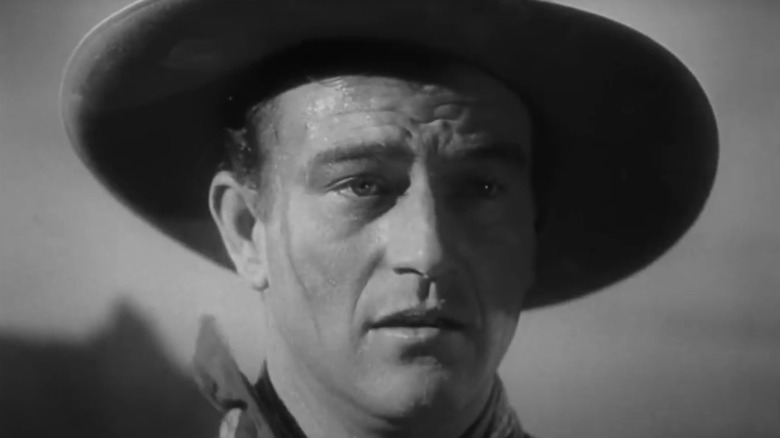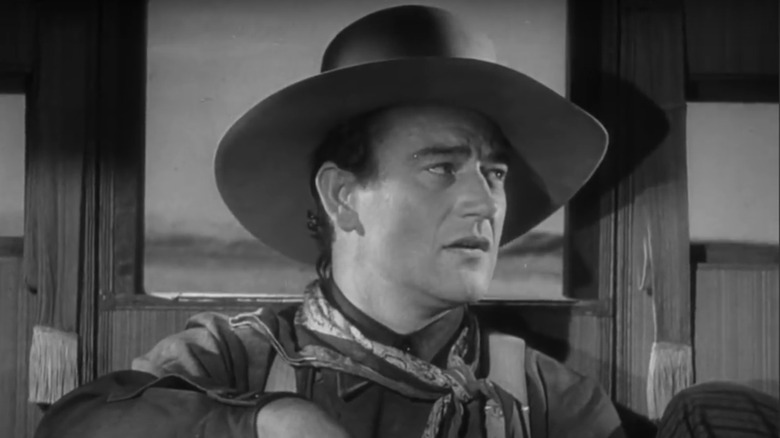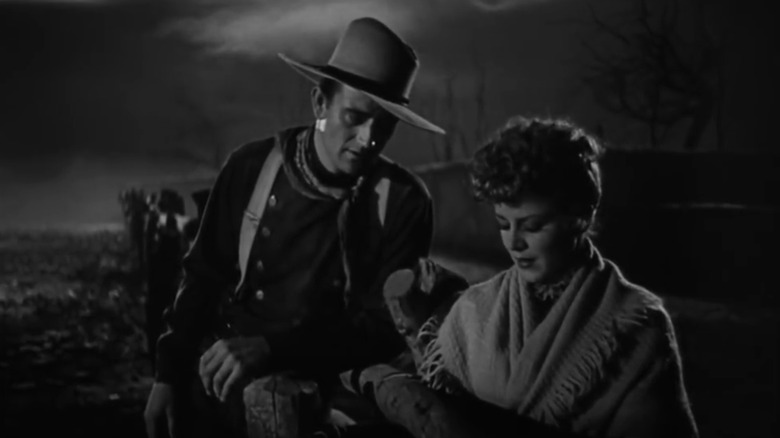Why John Wayne And John Ford Briefly Clashed On The Set Of Stagecoach
In 1928, John Ford made his last silent Western with "3 Bad Men." After this, it took 10 years for the director to return to the genre, which had been struggling throughout the '30s. But when he did come back, he did so with one of the most celebrated Westerns ever made in "Stagecoach."
The story of a group of seemingly mismatched travelers riding through Apache territory in the titular carriage turned out to be one of the most ingenious subversions of established cinematic tropes in the history of film. "Stagecoach" features characters who were ostensibly archetypes of the Western genre and, over the course of the narrative, reveals them all to be quite the opposite of what the audience expects. The film brings together a sex worker, a rich banker, a drunk, a salesman, a sheriff, a belle, a comic relief driver, and, of course, an outlaw. In "Stagecoach," the latter takes the form of Henry the "Ringo Kid," who's played by John Wayne in his first major "A" Western. Prior to starring in the film, Wayne had appeared in multiple B-movie examples of the genre and was only able to star in "Stagecoach" because Ford agreed to give Claire Trevor — then a much bigger star than Wayne — top billing. (Funding "Stagecoach" was an issue due to Wayne's lack of A-list projects.)
You'd think, then, that Wayne would feel indebted to Ford for standing strong when Walter Wanger Productions was pushing hard to have him replaced, so much so that he'd avoid any conflict at all costs. But it seems he didn't really have a choice in that regard. Instead, Ford had a plan for catapulting his then-young star into the big time — one that would see him and Wayne clash early on during production.
John Ford wasn't going to let John Wayne ease into his first big movie
In a letter to his wife, photographer Ned Scott, who worked on the set of "Stagecoach," wrote about the tough conditions on-set. He called the crew "crazy" for their 5am to 6pm schedule and reported that they were working in an environment he described as "Dust galore — wind — rain — snow — and more WIND." These were the conditions under which John Ford and his collaborators were filming, which weren't exactly conducive to an easy-going production.
For John Wayne, who found himself starring in his first major Western picture, he'd have more than inclement weather to deal with. John Ford had waited to bring Wayne into the big leagues for some time, in order to give the actor time to mature. "Stagecoach" was the point at which the director felt the budding star had reached the right stage in his career and life in general to adequately portray the Ringo Kid. But it seems Ford wasn't just going to let Wayne figure things out for himself now that he was in a major "A" feature.
In a clip from the documentary "Directed by John Ford" (via the American Film Institute), Wayne recalled his second day filming on "Stagecoach." Ford and his crew were shooting a big scene wherein Wayne was required to stand in the background and wash his face. It seemed like a simple enough scene for the actor, but Ford had other plans. "[Ford] has me washing my face and drying it," remembered Wayne. "He'd say, 'Cut, all right,' he'd look over at me and say, 'Let's do it again.' Now I become conscious that he's certainly paying a lot of attention to me with that scene going on over there." The director wouldn't let up, repeatedly rebuking the Duke for not washing his face correctly. ("He says, 'Cut. Duke you're dabbing your face can't you wash?' and I said, 'I am washing!'") As this went on, however, Wayne continued to push back until Ford found himself facing down the entire cast. But it seems this was all part of the director's plan.
John Ford had a plan for John Wayne
John Ford gave John Wayne such a hard time on his first big feature that you could say Wayne's "Stagecoach" performance was pulled out of him by force. According to Ronald L. Davis' "Duke: The Life and Image of John Wayne," the director was unrelenting in his chastising of the young star, "berat[ing] and bull[ying]" him for weeks. According to Wayne, however, that incident with the wash cloth on the second day of shooting was all that was needed to get what Ford needed out of the actor.
In his "Directed by John Ford" interview, Wayne recalled how after multiple takes he managed to get the cast and crew on his side. "Finally, all the crew, all the actors, the cast, was completely on my side. From then on I had the cast helping me, as my first time really in the big time working with so many top people."
Asked if he thought Ford was intentionally giving him a hard time, Wayne said, "I know he planned it that way. He has a way of picking on actors when they're not too important a part of a scene in order to get them on their toes. So, they'll come in ready when they really have something to do, and then he handles you like a baby."
Ford made a habit out of this aggressive approach for most of his career, making life miserable for everyone while shooting 1962's "The Man Who Shot Liberty Valance." Today, such tactics are thankfully unacceptable, though there are, unfortunately, a few directors who, at the very least, seem fond of Ford's browbeating.


